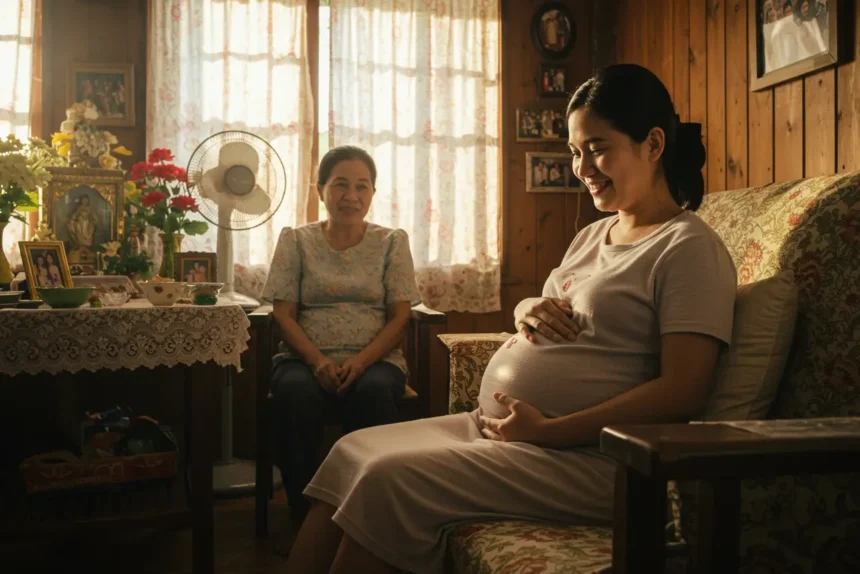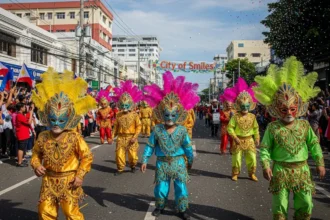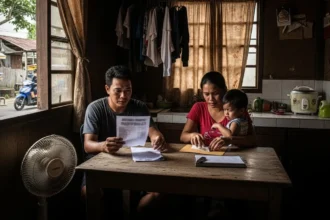Every Filipino mom knows – the moment you announce you’re pregnant, the pamahiin start rolling in faster than your morning sickness. “Bawal magputol ng buhok!” says one tita. “Huwag kang lalabas pag may eclipse!” adds another. From paglilihi cravings to the no-bathing-after-birth rule, Filipino pregnancy superstitions have been around for generations – and somehow, they’re still alive today.
- 🍋 1. Paglilihi and Food Cravings – “Don’t Deny Your Cravings!”
- 🚪 2. Bawal Umupo sa Pintuang Bukas – “Don’t Sit by the Door!”
- 🌘 3. Solar or Lunar Eclipse – “Takpan ang Tiyan!”
- 🚿 4. Bawal Maligo Pagkapanganak – “No Bathing After Giving Birth!”
- 😢 5. Bawal Umiyak o Magalit Habang Buntis – “Keep Your Emotions Calm”
- ⚰️ 6. Bawal Pumunta sa Burol – “Don’t Attend Wakes or Funerals”
- 💇 7. Bawal Magputol ng Buhok Habang Buntis – “Don’t Cut Your Hair While Pregnant”
- 🛏️ 8. Sleeping Position Superstitions – “Huwag Humiga Nang Patalikod o Nakadapa!”
- 🧿 9. Usog and Red Thread Protection – “Iwasan Mong Ma-Usog si Baby!”
- 👶 10. Cutting Baby’s Nails or Hair Too Early – “Baka Hindi Tumalino si Baby!”
- ❓ FAQs About Filipino Pregnancy & Newborn Superstitions
- 🌼 Between Science and Lola’s Wisdom
- 🧭 References
These beliefs were passed down by our lolas and great-grandmothers, rooted in caution, care, and sometimes a bit of fear. They reflect how our culture protects mothers and newborns – even before doctors and Google existed. And while science might roll its eyes, there’s something endearing about how every family has their own version of bawal ito, bawal ‘yan.
In this article, we’ll look at 10 common Filipino pregnancy and newborn pamahiin, the meanings behind them, and whether modern moms still follow them today. Some are harmless, others a little wild – but all are part of the fascinating mix of love, folklore, and faith that make up the Filipino motherhood experience.

🍋 1. Paglilihi and Food Cravings – “Don’t Deny Your Cravings!”
Ask any Filipino mom, and she’ll have a paglilihi story that’s both funny and sacred. It’s that magical (and sometimes frustrating) phase early in pregnancy when cravings take over – bigla na lang gusto ng manggang hilaw, or ayaw sa amoy ng sinigang. But to Filipino elders, paglilihi isn’t just about food – it’s a glimpse into what your baby will become.
According to lola wisdom, cravings reveal the baby’s future looks and traits. If a mom craves white foods like siopao, gatas, or puto, the baby will have fair skin. If she eats dark foods like dinuguan or chocolate, baka raw maitim si baby. Craving mangga with bagoong? Expect a baby with rosy cheeks or pilyong ngiti.
But it doesn’t stop there – some foods are said to be bawal. Lola might warn:
- “Huwag kang kakain ng kambal na saging!” – or you might give birth to twins.
- “Huwag kang kakain ng pusit!” – or the baby might have dark marks or umbilical cord issues.
- “Iwasan mo ang talong!” – it’s “too cold” for the body and might make the pregnancy delicate.
Others even say a pregnant woman shouldn’t look at ugly images or animals, lest her baby “inherit” that appearance. It sounds absurd today, but in traditional Filipino culture, paglilihi was treated as a delicate time – when the mother’s emotions and desires were believed to directly shape the baby’s spirit and form.
And of course, denying cravings is a big no-no. Refuse a craving, they say, and your child might grow up malungkutin, iyakin, or matampuhin. So when a pregnant woman whispers “Gusto ko ng sinangag at tuyo sa hatinggabi,” her partner usually rushes to the kitchen – or to the nearest sari-sari store.
Interestingly, there’s also a spiritual side to it. Some families say cravings reveal ancestral guidance – that a late-night hunger for a certain food means an elder’s blessing is watching over the pregnancy. Others treat it as the baby’s way of communicating – a playful sign of early personality.
Science will tell you paglilihi stems from hormonal shifts, taste sensitivity, and the body’s search for nutrients. But for many Filipinos, it’s more than that – it’s tradition, connection, and a shared story between generations. Because in every craving satisfied, there’s care; in every midnight snack, a quiet prayer that both mother and child will be safe, healthy, and full of grasya.

🚪 2. Bawal Umupo sa Pintuang Bukas – “Don’t Sit by the Door!”
It’s one of those pamahiin sa buntis you’ll hear the moment you plop down to rest – “Anak, huwag kang uupo sa may pinto, mahihirapan kang manganak!”
This superstition warns pregnant women not to sit or linger by the doorway. The belief says that doing so “blocks the passage,” symbolizing a difficult or delayed delivery. In some older Filipino homes, even just standing by the open door for too long was frowned upon – parang sinasarhan mo ang daan ng suwerte at ligtas na panganganak.
On a symbolic level, the door represents transition – an entrance or exit, much like childbirth itself. Sitting there is seen as tempting fate or “getting stuck” between two worlds. Lola logic says the baby might struggle to come out, mirroring the mother’s position of blocking an entryway.
Some also say it’s bastos sa bisita – an old custom of respect. Sitting by the door could obstruct someone entering, which was equated with bad manners. Over time, that cultural politeness evolved into a pregnancy superstition – a way to remind expectant mothers to stay comfortable, seated away from drafts, and not in the path of people coming and going.
Interestingly, there’s a bit of practical sense, too. Sitting by the door exposes you to sudden gusts of air (hampas ng hangin) or lamig – things that elders believed could cause pananakit ng likod or chills. It’s an old-school way of saying, “Keep yourself warm and safe, ‘wag kang ginawin.”
So while science doesn’t connect doorways to childbirth, the wisdom behind it still stands: don’t place yourself in the path of discomfort or distraction – especially when you’re nurturing life.
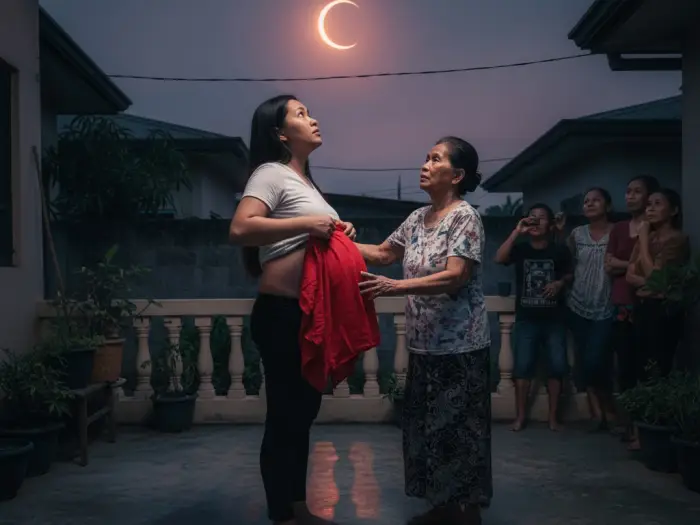
🌘 3. Solar or Lunar Eclipse – “Takpan ang Tiyan!”
Few pamahiin sa buntis cause more panic than this one: when the moon or sun darkens, Filipino elders rush to say – “Takpan mo ang tiyan mo! Baka maipanganak may bingot si baby!”
During an eclipse (eclipse ng araw o buwan), pregnant women are told to cover their bellies with a red cloth, a towel, or even a kitchen apron. The belief goes that an eclipse – especially a lunar one – could “mark” the baby, causing birth defects like a cleft lip or other deformities. Some lolas even say a pregnant woman shouldn’t look at the eclipse at all, baka madaplisan ng anino si baby.
This superstition actually has ancient roots, shared by many cultures across Asia and Latin America. Before science explained eclipses, they were seen as bad omens – a cosmic battle between light and darkness. In Filipino folklore, that darkness could “bite” the unborn child if the mother wasn’t protected. The red cloth? It’s said to ward off evil spirits and bad energy, acting as both shield and charm.
Even today, many moms still follow this – “Wala namang mawawala,” they say, wrapping their bellies just in case. Some even avoid cooking, cutting anything sharp, or stepping outside until the eclipse passes.
Modern medicine, of course, has no link between eclipses and birth defects. But the enduring belief reveals something deeper – the instinct to protect life from unseen harm. It’s not fear; it’s love wrapped in tradition.
Because whether it’s a real threat or not, the gesture of covering the belly says it all: “I’ll do anything to keep my baby safe – even from the sky itself.”

🚿 4. Bawal Maligo Pagkapanganak – “No Bathing After Giving Birth!”
This one might sound strange to modern ears, but ask any lola or manang and she’ll nod seriously – “Huwag kang maliligo agad, anak! Mabubuwal ka!”
One of the most enduring Filipino postpartum pamahiin is the belief that new mothers should avoid bathing for several days (or even weeks) after childbirth. Some say three days, others say seven – and a few more traditional ones insist on a full month. The reason? To prevent pasma (a folk illness described as the body’s imbalance due to exposure to cold) and protect the mother’s recovery.
The logic goes like this: after giving birth, a woman’s body is weak, her pores “open,” and her blood flow unstable. If she bathes too soon – especially with cold water – “papasok ang lamig sa katawan” leading to chills, joint pain, headaches, or worse, long-term frailty.
Instead, lolas recommend “hugas lang muna” using warm tubig na may dahon ng guava or sambong. Some prepare herbal steam baths (suob) after a week or two – a mix of heat therapy and relaxation believed to help the body regain balance.
This practice isn’t unique to the Philippines; similar postpartum taboos exist across Southeast Asia and Latin America. While modern doctors now emphasize hygiene and proper wound care, they also acknowledge the self-care value hidden in these traditions – rest, warmth, and recovery before resuming daily chores.
Many modern moms now modify the rule – skipping full showers for a day or two, then using warm water and gentle soap. Some even say “Basta hindi malamig, okay lang.”
In the end, the belief reflects the same intention: protect the mother, keep her warm, and give her time to heal. Science may have replaced superstition, but the wisdom of rest and care remains timeless.

😢 5. Bawal Umiyak o Magalit Habang Buntis – “Keep Your Emotions Calm”
If you’ve ever seen a Filipino lola gently pat a pregnant woman’s arm during a family argument, you’ve likely heard her whisper, “’Wag ka nang magalit, baka maapektuhan si baby.”
This pamahiin centers on the belief that a mother’s emotions – especially anger, sadness, or fear – directly affect her unborn child. Elders warn that if a pregnant woman cries too much, “magiging iyakin si baby,” and if she’s often angry, “susungitan din ‘yan paglaki.”
In truth, this is one superstition that makes sense psychologically and medically. Modern science agrees that stress hormones like cortisol can affect a baby’s development when a mother experiences prolonged anxiety or distress. But Filipino tradition took it a step further – turning emotional health into moral guidance.
You’ll often hear family members reminding expectant moms to stay cheerful, avoid overthinking, and surround themselves with laughter. Some even encourage pregnant women to watch comedies, listen to music, and talk to the baby with love – all believed to shape the child’s magandang ugali and joyful spirit.
Of course, there’s also a cultural layer here. Filipino families value harmony, and pregnancy is seen as a sacred time that should be protected from conflict. That’s why lolas and titas often act as “emotional bodyguards,” stepping in to soothe tension before it reaches the expectant mom.
Whether or not tears really “transfer” to the womb, this belief captures something beautiful – the Filipino idea that love, peace, and good vibes start even before a baby is born. Because in our culture, a calm, happy mom means a calm, happy home.
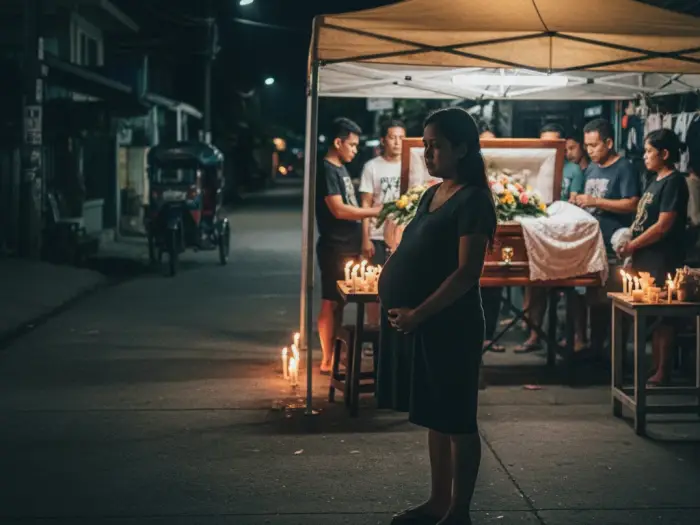
⚰️ 6. Bawal Pumunta sa Burol – “Don’t Attend Wakes or Funerals”
Among all pamahiin sa buntis, this one often sparks debate – especially when someone close passes away. Elders will insist: “Bawal sa buntis ang burol! Baka maapektuhan si baby!”
The superstition warns pregnant women not to attend funerals, wakes, or cemeteries. The reason varies depending on who you ask. Some say it’s because death energy or spirits might cling to the mother or child. Others believe that seeing or smelling the environment of death can bring bad luck or emotional distress that could harm the baby.
One popular version says if a pregnant woman must attend a wake, she should wear a red ribbon or cloth – usually tied around her belly – to ward off negative energy and restless spirits. It’s the same belief applied during eclipses or hospital visits – red protects life and repels darkness.
Practical explanations also exist. Funerals can be emotionally heavy and physically exhausting. In the past, wakes were often held in warm, crowded homes where smoke from candles and incense filled the air – hardly ideal for an expectant mom who might already struggle with nausea or fatigue.
So the superstition, in a way, acted as cultural protection – a gentle way of telling mothers to rest, avoid sadness, and shield themselves from stress during a vulnerable time.
Many Filipinos still follow this today, even if partly for peace of mind. And when someone insists “magpahinga ka na lang, bawal sa buntis yan,” it’s rarely out of fear – it’s out of care. Because in Filipino families, keeping a pregnant woman safe means guarding not just her body, but her spirit too.
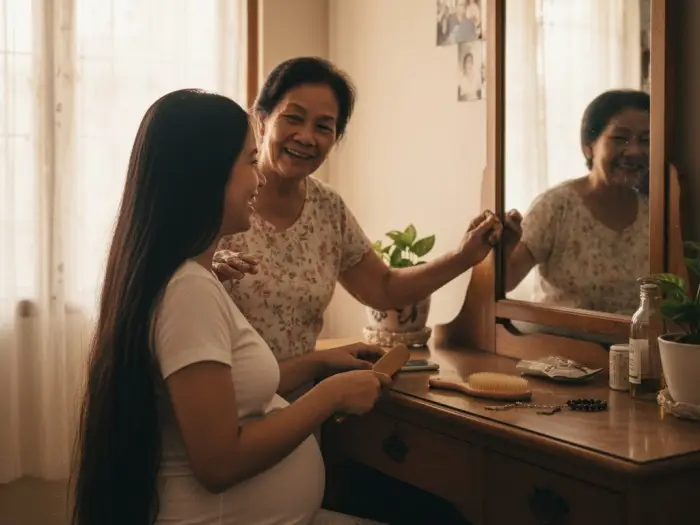
💇 7. Bawal Magputol ng Buhok Habang Buntis – “Don’t Cut Your Hair While Pregnant”
Another timeless pamahiin sa buntis says a woman should not cut her hair while pregnant, or “baka umikli ang buhay ng baby.”
This superstition likely came from a mix of ancient symbolism and old health fears. In Filipino culture – and many others across Asia – hair represents vitality and life force. Cutting it during pregnancy was thought to “cut” the baby’s strength or shorten their life. Some elders also believed it could cause a difficult birth, or that the baby would be born with thin or sparse hair.
Back in the day, women were also discouraged from going to salons because of hygiene and safety concerns – especially when barbershops used razors and chemicals. Over time, those warnings evolved into this pamahiin, wrapped with mystical explanation to make it more convincing for young mothers.
Some versions are gentler: “Huwag mong ipagupit, sayang ang ganda mo habang buntis.” Others warn that the baby might inherit a “cut fate” or be separated early from the mother.
Still, many modern moms don’t take it too seriously. They get trims for comfort, especially when the weather’s hot, and just avoid anything drastic “para iwas chismis ni lola.”
Interestingly, the belief also touches something emotional – the idea that pregnancy is temporary and precious, and every part of it, even a woman’s changing appearance, is sacred. Whether or not hair has power, the message is clear: protect the life you’re carrying, and honor the season you’re in.

🛏️ 8. Sleeping Position Superstitions – “Huwag Humiga Nang Patalikod o Nakadapa!”
Another pamahiin that’s practically shouted across Filipino households: “Huwag kang hihiga nang patalikod, baka malagutan ng hininga si baby!” or “Huwag nakadapa, baka mahirapan kang manganak!”
Sleeping positions are a big deal in traditional Filipino pregnancy care. The most common warning? Don’t lie flat on your back – it’s believed to press on the baby or the mother’s lungs, causing complications. Some also say don’t sleep with arms and legs spread out, because it “opens” the body too much and invites negative spirits or pagod na hangin (bad wind).
Scientifically, there’s a bit of truth hiding in there. Doctors today recommend that pregnant women – especially in later months – sleep on their left side to improve circulation for both mother and baby. It prevents pressure on major veins and helps oxygen flow better. So yes, lola’s advice wasn’t entirely superstition – just a bit poetic.
Other sleeping taboos include not sleeping during the day (“baka tamad si baby!”) and not lying crosswise on the bed (“baka magulo ulo ng bata”). Some even say if a pregnant woman sleeps with her legs crossed, the umbilical cord might wrap around the baby’s neck.
While modern medicine replaces fear with science, these beliefs still serve a purpose: they remind mothers to rest with care. Filipino culture always treated sleep as sacred – a time to recharge both body and spirit. And for expectant moms, that meant protecting the baby even in dreams.
Because whether through old superstition or modern advice, every whispered “Huwag ka nang humiga nang ganyan, anak” comes from the same place – pagmamahal at pag-aalaga.

🧿 9. Usog and Red Thread Protection – “Iwasan Mong Ma-Usog si Baby!”
No topic makes lolas more alert than this one – “’Wag mong iwan si baby sa bisita, baka ma-usog!”
In Filipino culture, usog refers to the belief that a baby (or even an adult) can be harmed by another person’s energy or masamang hangin after being greeted or admired. The symptoms? A sudden fever, restlessness, or non-stop crying – all blamed on being na-usog.
To protect babies, elders follow several rituals. The most famous one: dab a little saliva on the baby’s tummy, forehead, or foot right after greeting them. It sounds odd, but it’s done out of pure affection – a way to “neutralize” the visitor’s energy. Some say the person must also say “Pwera usog” or “Tabi-tabi po.”
Another form of protection is the red string or thread tied around a baby’s wrist, ankle, or pinned onto their clothes. Red is believed to repel envy, illness, and bad spirits – a symbol of warmth and life force. In some areas, mothers also pin garlic or bawang under the baby’s pillow or clothing to ward off lamig and engkanto.
While modern parents may laugh at the idea, many still follow it “para sigurado.” Some even replace the red thread with cute anklets or bracelets. Pediatricians now explain that crying after being greeted is often just overstimulation – but that doesn’t stop Filipino moms from whispering a quick “Pwera usog” just in case.
At its core, the usog belief shows the Filipino instinct to protect life from unseen forces, to respect the unknown, and to guard a baby’s peace – one tiny red thread and gentle prayer at a time.

👶 10. Cutting Baby’s Nails or Hair Too Early – “Baka Hindi Tumalino si Baby!”
This pamahiin makes almost every new parent pause before reaching for the baby nail cutter – “Huwag mo munang gupitan! Baka hindi tumalino!”
According to Filipino elders, cutting a newborn’s nails or hair too soon – usually before their first birthday or before they learn to speak – can bring bad luck or delay milestones like talking and walking. Some even say that trimming hair too early can “cut off” the baby’s wisdom or intelligence.
To work around this, lolas suggest waiting a few months before the first haircut, then turning it into a little ritual. Some keep the first lock of hair or tiny nail clippings inside a book or Bible, believing it brings blessing and knowledge. Others bury it near the house or store it in a small pouch for good luck sa pag-aaral.
There’s also a more practical side: newborns have extremely soft nails and delicate scalps, so cutting too early could cause accidental scratches or injury – another reason older generations avoided it.
In modern times, parents still tread carefully, mixing old beliefs with new knowledge. Many wait for a few weeks or months, then use safe baby nail scissors or have the first haircut done at a trusted salon. Some even keep a snippet as a sweet keepsake – a blend of superstition and sentimentality.
It’s one of those charming pamahiin that may not have science behind it, but reminds us how Filipino culture sees every stage of a baby’s growth as sacred – worth celebrating, protecting, and remembering.
❓ FAQs About Filipino Pregnancy & Newborn Superstitions
- What are the most common Filipino pregnancy superstitions?
Filipino moms still hear pamahiin like not cutting hair, covering the belly during an eclipse, avoiding wakes, and satisfying food cravings during paglilihi. - What does “pamahiin sa buntis” mean?
It refers to traditional pregnancy superstitions or old beliefs passed down through generations to protect both the mother and baby. - Why do Filipinos believe in not bathing after childbirth?
It’s believed that bathing too soon can cause pasma or chills because the body is still weak and “open” after giving birth. Warm sponge baths or herbal washes are preferred instead. - Why do pregnant women cover their stomachs during an eclipse?
The red cloth tradition comes from the belief that eclipses bring harmful energy that can mark or harm the unborn baby. It’s done as protection. - What’s the meaning of “bawal umupo sa pinto”?
Sitting by the doorway is said to block blessings or cause a difficult delivery – symbolizing the baby being “stuck” during labor. - Why is crying or anger discouraged during pregnancy?
Elders believe negative emotions affect the baby’s temperament. Modern science agrees that too much stress can impact the baby’s development. - What is “usog,” and how do Filipinos prevent it?
Usog is when a baby becomes ill or irritable after being greeted by someone with strong energy. People say “Pwera usog” and dab saliva or use a red thread to ward it off. - Why do some mothers wait to cut their baby’s hair or nails?
It’s believed that cutting too early could delay speech or reduce intelligence, so many wait a few months and turn it into a small blessing ritual. - Are these pregnancy pamahiin still followed today?
Yes – even modern moms follow them partly for tradition and partly out of respect for elders. They’re seen as acts of care more than strict rules. - Do these superstitions have scientific basis?
Most are cultural and symbolic, but some overlap with practical health advice – like resting after birth or avoiding stress. They blend folklore and real maternal wisdom.

🌼 Between Science and Lola’s Wisdom
Pregnancy and motherhood in the Philippines are never just medical journeys – they’re woven with stories, pamahiin, and love passed down from generations who simply wanted moms and babies safe. From paglilihi cravings to the red thread around a newborn’s wrist, every superstition reflects one thing: care disguised as caution.
Sure, modern science can explain most of them now. But deep down, these beliefs are less about fear and more about faith – faith that unseen forces exist, and that a mother’s love, backed by community and tradition, has power of its own.
So when lola reminds you not to cut your hair or to cover your belly during an eclipse, maybe just smile and say “Opo, La.” You don’t have to believe every pamahiin to appreciate the heart behind it – the generations of women who carried life, protected it the best way they knew how, and prayed that every child would be born healthy and blessed.
Because whether guided by science or superstition, one truth never changes: a Filipino mother’s instinct to protect will always be her strongest magic.
🧭 References
- Makati Medical Center – 6 Pregnancy Superstitions Debunked
- Cordlife Philippines – Pregnancy Myths vs Facts
- Hello Doctor PH – Filipino Health Pamahiins and the Truth Behind Them
- Culture-Based Beliefs and Practices on Pregnancy – Philippine Journals
- Binat Sa Panganganak – Hello Doctor PH



